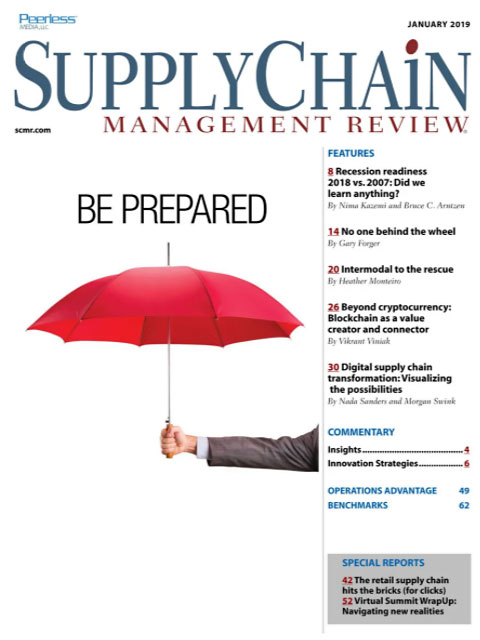Sorry, but your login has failed. Please recheck your login information and resubmit. If your subscription has expired, renew here.
January-February 2019
Truth be told, I was not a Boy Scout, or at least not a very good scout and not for very long. But I think there are some lessons for supply chain managers in the Scout motto: Be prepared. When I Wiki’d it this morning, I found the following: Be prepared, which means you are always in a state of readiness in mind and body to do your duty. Browse this issue archive.Need Help? Contact customer service 847-559-7581 More options
While the truck driver crisis seems to have stabilized recently, there remains a dramatic shortage of drivers with no solution in sight. Yet, as this article will discuss, the development and growing use of intermodal facilities around the United States could play an important role in increasing the number of truck drivers on the road.
One example of this emerging phenomenon is the development of the Port of Willamette Brooks Intermodal and Transload Facility*. There, the Oregon Department of Transportation is funding a single site for development of an intermodal transfer facility to serve the market of abundant agricultural products exported from the Willamette Valley Area. One of the two finalists for the proposal for funding is the Port of Willamette in Brooks, Oregon. While the state’s highest intent for funding the facility is to provide better logistics connectivity for the region’s producers, the facility will also considerably improve conditions for the region’s truck drivers.
The following passage is a brief excerpt from the Oregon Port of Willamette Brooks Intermodal and Transload Facility proposal submitted to the Oregon Department of Transportation. It tells the story of a day in the life of a driver delivering an imported container from Seattle and then returning the empty container:
[After picking up a container at the Port of Seattle] the driver then heads south to Eugene, which is 283 miles from the Port of Seattle. This trip will take the driver about six hours on average including stops at inspection stations, which could put the driver into Eugene at 3:00 p.m. Upon arrival at ACME Products in Eugene, the truck/40-foot container must be offloaded. The amount of time needed to do this varies, but can take approximately 1 hour to 3.5 hours per container. Using the worst-case assumption, the container would be completely unloaded by 6:30 p.m. The driver can then head back toward Seattle.

This complete article is available to subscribers only.
Log in now for full access or start your PLUS+ subscription for instant access.
SC
MR
Sorry, but your login has failed. Please recheck your login information and resubmit. If your subscription has expired, renew here.
January-February 2019
Truth be told, I was not a Boy Scout, or at least not a very good scout and not for very long. But I think there are some lessons for supply chain managers in the Scout motto: Be prepared. When I Wiki’d it this… Browse this issue archive. Access your online digital edition. Download a PDF file of the January-February 2019 issue.While the truck driver crisis seems to have stabilized recently, there remains a dramatic shortage of drivers with no solution in sight. Yet, as this article will discuss, the development and growing use of intermodal facilities around the United States could play an important role in increasing the number of truck drivers on the road.
One example of this emerging phenomenon is the development of the Port of Willamette Brooks Intermodal and Transload Facility*. There, the Oregon Department of Transportation is funding a single site for development of an intermodal transfer facility to serve the market of abundant agricultural products exported from the Willamette Valley Area. One of the two finalists for the proposal for funding is the Port of Willamette in Brooks, Oregon. While the state's highest intent for funding the facility is to provide better logistics connectivity for the region's producers, the facility will also considerably improve conditions for the region's truck drivers.
The following passage is a brief excerpt from the Oregon Port of Willamette Brooks Intermodal and Transload Facility proposal submitted to the Oregon Department of Transportation. It tells the story of a day in the life of a driver delivering an imported container from Seattle and then returning the empty container:
[After picking up a container at the Port of Seattle] the driver then heads south to Eugene, which is 283 miles from the Port of Seattle. This trip will take the driver about six hours on average including stops at inspection stations, which could put the driver into Eugene at 3:00 p.m. Upon arrival at ACME Products in Eugene, the truck/40-foot container must be offloaded. The amount of time needed to do this varies, but can take approximately 1 hour to 3.5 hours per container. Using the worst-case assumption, the container would be completely unloaded by 6:30 p.m. The driver can then head back toward Seattle.
SC
MR


Latest Supply Chain News
- Services sector sees growth in October, reports ISM
- Balanced supply chain management Part 4: The key—leading beyond the silo
- Managing inbound freight: What has changed in two decades?
- Inbound freight: Often a missed opportunity
- Aggregators sitting on the throne of Africa’s e-commerce supply chains: What lessons can we learn?
- More News
Latest Resources

 Explore
Explore
Procurement & Sourcing News
- Aggregators sitting on the throne of Africa’s e-commerce supply chains: What lessons can we learn?
- Cross-border transport 2024: Navigating the surge
- Benchmarking the complexity of ESG reporting
- Looking back at NextGen 2024
- The Corporate Sustainability Due Diligence Directive
- How to make your CFO a supply chain superfan
- More Procurement & Sourcing
Latest Procurement & Sourcing Resources

Subscribe

Supply Chain Management Review delivers the best industry content.

Editors’ Picks





